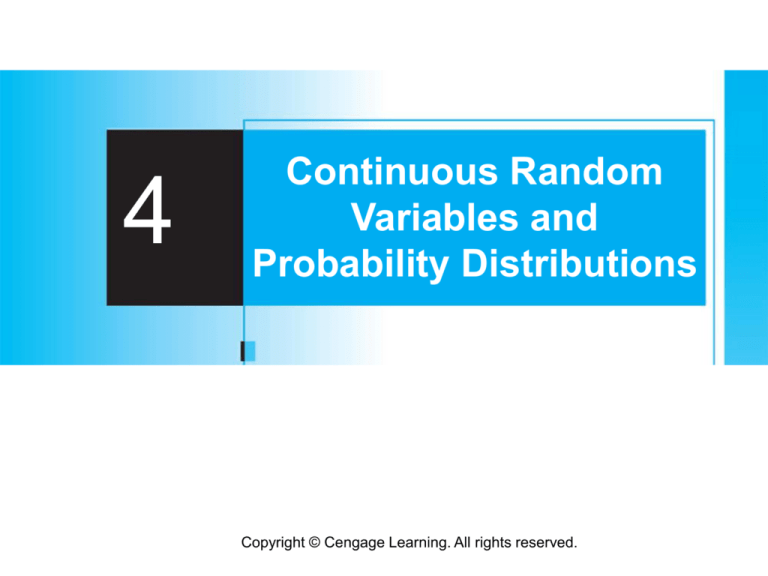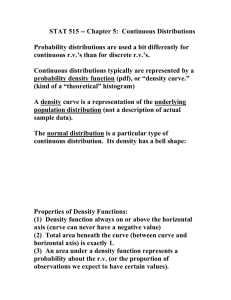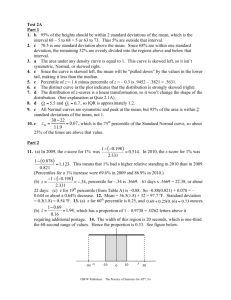
4
Continuous Random
Variables and
Probability Distributions
Copyright © Cengage Learning. All rights reserved.
4.3
The Normal
distribution
Copyright © Cengage Learning. All rights reserved.
The Normal Distribution
The normal distribution is the most important one in all of
probability and statistics. Many numerical populations have
distributions that can be fit very closely by an appropriate
normal curve.
Examples include heights, weights, and other physical
characteristics (the famous 1903 Biometrika article “On the
Laws of Inheritance in Man” discussed many examples of
this sort), measurement errors in scientific experiments,
anthropometric measurements on fossils, reaction times in
psychological experiments, measurements of intelligence
and aptitude, scores on various tests, and numerous
economic measures and indicators.
3
The Normal Distribution
Definition
Again e denotes the base of the natural logarithm system
and equals approximately 2.71828, and represents the
familiar mathematical constant with approximate value
3.14159.
4
The Normal Distribution
The statement that X is normally distributed with
parameters and 2 is often abbreviated X ~ N(, 2).
Clearly f(x; , ) 0, but a somewhat complicated calculus
argument must be used to verify that
f(x; , ) dx = 1.
It can be shown that E(X) = and V(X) = 2, so the
parameters are the mean and the standard deviation of X.
5
The Normal Distribution
Figure 4.13 presents graphs of f(x; , ) for several
different (, ) pairs.
Two different normal density curves
Figure 4.13(a)
Visualizing and for a normal
distribution
Figure 4.13(b)
6
The Normal Distribution
Each density curve is symmetric about and bell-shaped,
so the center of the bell (point of symmetry) is both the
mean of the distribution and the median.
The mean 𝜇 is a location parameter, since changing its
value rigidly shifts the density curve to one side or the
other; 𝜎 is referred to as a scale parameter, because
changing its value stretches or compresses the curve
horizontally without changing the basic shape..
7
The Normal Distribution
The inflection points of a normal curve (points at which the
curve changes from turning downward to turning upward)
occur at - and + . Thus the value of s can be
visualized as the distance from the mean to these inflection
points.
A large value of s corresponds to a density curve that is
quite spread out about , whereas a small value yields a
highly concentrated curve
The larger the value of , the more likely it is that a value of
X far from the mean may be observed.
8
The Standard Normal
Distribution
9
The Standard Normal Distribution
The computation of P(a X b) when X is a normal rv with
parameters and requires evaluating
(4.4)
None of the standard integration techniques can be used to
accomplish this. Instead, for = 0 and = 1, Expression
(4.4) has been calculated using numerical techniques
and tabulated for certain values of a and b.
This table can also be used to compute probabilities for any
other values of and under consideration.
10
The Standard Normal Distribution
Definition
11
The Standard Normal Distribution
The standard normal distribution almost never serves as a
model for a naturally arising population.
Instead, it is a reference distribution from which information
about other normal distributions can be obtained.
Appendix Table A.3 gives
= P(Z z), the area under the
standard normal density curve to the left of z, for
z = –3.49, –3.48,..., 3.48, 3.49.
12
The Standard Normal Distribution
Figure 4.14 illustrates the type of cumulative area
(probability) tabulated in Table A.3. From this table, various
other probabilities involving Z can be calculated.
Standard normal cumulative areas tabulated in Appendix Table A.3
Figure 4.14
13
Example 4.13
Let’s determine the following standard normal probabilities:
(a) P(Z 1.25),
(b) P(Z > 1.25),
(c) P(Z –1.25), and
(d) P(–.38 Z 1.25).
a. P(Z 1.25) = (1.25), a probability that is tabulated in
Appendix Table A.3 at the intersection of the row
marked 1.2 and the column marked .05.
The number there is .8944, so P(Z 1.25) = .8944.
14
Example 4.13
cont’d
Figure 4.15(a) illustrates this probability.
Normal curve areas (probabilities) for Example 13
Figure 4.15(a)
b. P(Z > 1.25) = 1 – P(Z 1.25) = 1 – (1.25), the area
under the z curve to the right of 1.25 (an upper-tail
area). Then (1.25) = .8944 implies that
P(Z > 1.25) = .1056.
15
Example 4.13
cont’d
Since Z is a continuous rv, P(Z 1.25) = .1056.
See Figure 4.15(b).
Normal curve areas (probabilities) for Example 13
Figure 4.15(b)
c. P(Z –1.25) = (–1.25), a lower-tail area. Directly from
Appendix Table A.3, (–1.25) = .1056.
By symmetry of the z curve, this is the same answer as
in part (b).
16
Example 4.13
cont’d
d. P(–.38 Z 1.25) is the area under the standard
normal curve above the interval whose left endpoint is
–.38 and whose right endpoint is 1.25.
From Section 4.2, if X is a continuous rv with cdf F(x),
then P(a X b) = F(b) – F(a).
Thus P(–.38 Z 1.25) =
(1.25) –
(–.38)
= .8944 – .3520
= .5424
17
Example 4.13
cont’d
See Figure 4.16.
P(–.38 Z 1.25) as the difference between two cumulative areas
Figure 4.16
18
Example 4.13
e. P(Z ≤ 5) = Ф(5), the cumulative area under the z curve
to the left of 5. This probability does not appear in the table
because the last row is labeled 3.4. However, the last entry
in that row is Φ(3.49) = .9998. That is, essentially all of the
area under the curve lies to the left of 3.49 (at most 3.49
standard deviations to the right of the mean). Therefore we
conclude that P(Z ≤ 5) ≈1.
19
Percentiles of the Standard Normal
Distribution
20
Percentiles of the Standard Normal Distribution
For any p between 0 and 1, Appendix Table A.3 can be
used to obtain the (100p)th percentile of the standard
normal distribution.
21
Example 4.14
The 99th percentile of the standard normal distribution is
that value on the horizontal axis such that the area under
the z curve to the left of the value is .9900.
Appendix Table A.3 gives for fixed z the area under the
standard normal curve to the left of z, whereas here we
have the area and want the value of z. This is the “inverse”
problem to P(Z z) = ?
so the table is used in an inverse fashion: Find in the
middle of the table .9900; the row and column in which it
lies identify the 99th z percentile.
22
Example 4.14
cont’d
Here .9901 lies at the intersection of the row marked 2.3
and column marked .03, so the 99th percentile is
(approximately) z = 2.33.
(See Figure 4.17.)
Finding the 99th percentile
Figure 4.17
23
Example 4.14
cont’d
By symmetry, the first percentile is as far below 0 as the
99th is above 0, so equals –2.33 (1% lies below the first
and also above the 99th).
(See Figure 4.18.)
The relationship between the 1st and 99th percentiles
Figure 4.18
24
Percentiles of the Standard Normal Distribution
In general, the (100p)th percentile is identified by the row
and column of Appendix Table A.3 in which the entry p is
found (e.g., the 67th percentile is obtained by finding .6700
in the body of the table, which gives z = .44).
If p does not appear, the number closest to it is often used,
although linear interpolation gives a more accurate answer.
25
Percentiles of the Standard Normal Distribution
For example, to find the 95th percentile, we look for .9500
inside the table.
Although .9500 does not appear, both .9495 and .9505 do,
corresponding to z = 1.64 and 1.65, respectively.
Since .9500 is halfway between the two probabilities that
do appear, we will use 1.645 as the 95th percentile and
–1.645 as the 5th percentile.
26
z Notation for z Critical Values
27
z Notation for z Critical Values
In statistical inference, we will need the values on the
horizontal z axis that capture certain small tail areas under
the standard normal curve.
z notation Illustrated
Figure 4.19
28
z Notation for z Critical Values
For example, z.10 captures upper-tail area .10, and z.01
captures upper-tail area .01.
Since of the area under the z curve lies to the right of z,
1 – of the area lies to its left. Thus z is the 100(1 – )th
percentile of the standard normal distribution.
By symmetry the area under the standard normal curve to
the left of –z is also . The z s are usually referred to as
z critical values.
29
z Notation for z Critical Values
Table 4.1 lists the most useful z percentiles and z values.
Standard Normal Percentiles and Critical Values
Table 4.1
30
Example 4.15
z.05 is the 100(1 – .05)th = 95th percentile of the standard
normal distribution, so z.05 = 1.645.
The area under the standard normal curve to the left of
–z.05 is also .05. (See Figure 4.20.)
Finding z.05
Figure 4.20
31
Nonstandard Normal
Distributions
32
Nonstandard Normal Distributions
When X ~ N(, 2), probabilities involving X are computed
by “standardizing.” The standardized variable is (X – )/.
Subtracting shifts the mean from to zero, and then
dividing by scales the variable so that the standard
deviation is 1 rather than .
33
Nonstandard Normal Distributions
Proposition
34
Nonstandard Normal Distributions
The key idea of the proposition is that by standardizing, any
probability involving X can be expressed as a probability
involving a standard normal rv Z, so that Appendix Table
A.3 can be used.
This is illustrated in Figure 4.21.
Equality of nonstandard and standard normal curve areas
Figure 4.21
35
Nonstandard Normal Distributions
The proposition can be proved by writing the cdf of
Z = (X – )/ as
Using a result from calculus, this integral can be
differentiated with respect to z to yield the desired pdf
f(z; 0, 1).
36
Example 4.16
The time that it takes a driver to react to the brake lights on
a decelerating vehicle is critical in helping to avoid rear-end
collisions.
The article “Fast-Rise Brake Lamp as a CollisionPrevention Device” (Ergonomics, 1993: 391–395) suggests
that reaction time for an in-traffic response to a brake signal
from standard brake lights can be modeled with a normal
distribution having mean value 1.25 sec and standard
deviation of .46 sec.
37
Example 4.16
cont’d
What is the probability that reaction time is between 1.00
sec and 1.75 sec? If we let X denote reaction time, then
standardizing gives
1.00 X 1.75
if and only if
Thus
38
Example 4.16
cont’d
= P(–.54 Z 1.09) =
(1.09) –
(–.54)
= .8621 – .2946 = .5675
This is illustrated in Figure 4.22
Normal curves for Example 16
Figure 4.22
39
Example 4.16
cont’d
Similarly, if we view 2 sec as a critically long reaction
time, the probability that actual reaction time will exceed
this value is
40
Nonstandard Normal Distributions
These results are often reported in percentage form and
referred to as the empirical rule (because empirical
evidence has shown that histograms of real data can very
frequently be approximated by normal curves).
It is indeed unusual to observe a value from a normal
population that is much farther than 2 standard deviations
from m. These results will be important in the development
of hypothesis-testing procedures in later chapters
41
Percentiles of an Arbitrary Normal
Distribution
42
Percentiles of an Arbitrary Normal Distribution
The (100p)th percentile of a normal distribution with mean
and standard deviation is easily related to the (100p)th
percentile of the standard normal distribution.
Proposition
Another way of saying this is that if z is the desired
percentile for the standard normal distribution, then the
desired percentile for the normal (, ) distribution is z
standard deviations from .
43
Example 4.18
The authors of “Assessment of Lifetime of Railway Axle”
(Intl. J. of Fatigue, (2013: 40–46) used data collected from
an experiment with a specified initial crack length and
number of loading cycles to propose a normal distribution
with mean value 5.496 mm and standard deviation .067
mm for the rv X = final crack depth.
For this model, what value of final crack depth would be
exceeded by only .5% of all cracks under these
circumstances? Let c denote the requested value. Then the
desired condition is that P(X > c) = .005, or, equivalently,
that P(X ≤ c) = .995.
44
Example 4.18
cont’d
Thus c is the 99.5th percentile of the normal distribution
with µ = 5.496 and 𝜎 = .067. The 99.5th percentile of the
standard normal distribution is 2.58, so
45
The Normal Distribution and
Discrete Populations
46
The Normal Distribution and Discrete Populations
The normal distribution is often used as an approximation
to the distribution of values in a discrete population.
In such situations, extra care should be taken to ensure
that probabilities are computed in an accurate manner.
47
Example 4.19
IQ in a particular population (as measured by a standard
test) is known to be approximately normally distributed with
= 100 and = 15.
What is the probability that a randomly selected individual
has an IQ of at least 125?
Letting X = the IQ of a randomly chosen person, we wish
P(X 125).
The temptation here is to standardize X 125 as in
previous examples. However, the IQ population distribution
is actually discrete, since IQs are integer-valued.
48
Example 4.19
cont’d
So the normal curve is an approximation to a discrete
probability histogram, as pictured in Figure 4.24.
A normal approximation to a discrete distribution
Figure 4.24
The rectangles of the histogram are centered at integers,
so IQs of at least 125 correspond to rectangles beginning
at 124.5, as shaded in Figure 4.24.
49
Example 4.19
cont’d
Thus we really want the area under the approximating
normal curve to the right of 124.5.
Standardizing this value gives P(Z 1.63) = .0516,
whereas standardizing 125 results in P(Z 1.67) = .0475.
The difference is not great, but the answer .0516 is more
accurate. Similarly, P(X = 125) would be approximated by
the area between 124.5 and 125.5, since the area under
the normal curve above the single value 125 is zero.
50
Example 4.19
cont’d
The correction for discreteness of the underlying
distribution in Example 19 is often called a continuity
correction.
It is useful in the following application of the normal
distribution to the computation of binomial probabilities.
51
Approximating the Binomial
Distribution
52
Approximating the Binomial Distribution
Recall that the mean value and standard deviation of a
binomial random variable X are X = np and X =
respectively.
53
Approximating the Binomial Distribution
Figure 4.25 displays a binomial probability histogram for
the binomial distribution with n = 25,, p = .6, for which
= 25(.6) = 15 and = 25 .6 . 4) = 2.449
54
Approximating the Binomial Distribution
A normal curve with this and has been superimposed
on the probability histogram.
Although the probability histogram is a bit skewed (because
p .5), the normal curve gives a very good approximation,
especially in the middle part of the picture.
The area of any rectangle (probability of any particular
X value) except those in the extreme tails can be
accurately approximated by the corresponding normal
curve area.
55
Approximating the Binomial Distribution
For example,
P(X = 10) = B(10; 25, .6) – B(9; 25, .6) = .021,
whereas the area under the normal curve between 9.5 and
10.5 is P(–2.25 Z –1.84) = .0207.
More generally, as long as the binomial probability
histogram is not too skewed, binomial probabilities can be
well approximated by normal curve areas.
It is then customary to say that X has approximately a
normal distribution.
56
Approximating the Binomial Distribution
Proposition
57
Approximating the Binomial Distribution
A direct proof of this result is quite difficult. In the next
chapter we’ll see that it is a consequence of a more general
result called the Central Limit Theorem.
In all honesty, this approximation is not so important for
probability calculation as it once was.
This is because software can now calculate binomial
probabilities exactly for quite large values of n.
58
Example 4.20
Suppose that 25% of all students at a large public
university receive financial aid.
Let X be the number of students in a random sample of
size 50 who receive financial aid, so that p = .25.
Then = 12.5 and = 3.06.
Since np = 50(.25) = 12.5 10 and np = 37.5 10, the
approximation can safely be applied.
59
Example 4.20
cont’d
The probability that at most 10 students receive aid is
Similarly, the probability that between 5 and 15 (inclusive)
of the selected students receive aid is
P(5 X 15) = B(15; 50, .25) – B(4; 50, .25)
60
Example 4.20
cont’d
The exact probabilities are .2622 and .8348, respectively,
so the approximations are quite good.
In the last calculation, the probability P(5 X 15) is being
approximated by the area under the normal curve between
4.5 and 15.5—the continuity correction is used for both the
upper and lower limits.
61






